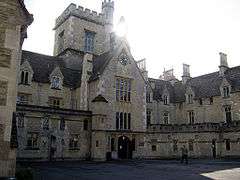Royal Agricultural University
 | |
| Motto |
Latin: Avorum Cultus Pecorumque; (from Virgil's Georgics) "Caring for the Fields and the Beasts" |
|---|---|
| Type | Public |
| Established |
2013 - University status 1845 - College |
| President | HRH The Prince of Wales |
| Principal | Professor Joanna Price |
| Students | 1,200 (2015/16)[1] |
| Undergraduates | 965 (2015/16)[1] |
| Postgraduates | 235 (2015/16)[1] |
| Location | Cirencester, Gloucestershire, UK |
| Campus | Rural |
| Colours | Black, maroon, yellow |
| Website | rau.ac.uk |
 | |
The Royal Agricultural University or RAU (previously known as the Royal Agricultural College or RAC) is a university located in Cirencester, Gloucestershire, UK. Established in 1845,[2] it was the first agricultural college in the English-speaking world.[3][4] The university provides more than 30 land-based undergraduate and postgraduate degree programmes to students from over 45 countries through the School of Agriculture, the School of Business and Entrepreneurship, the School of Equine and the School of Real Estate & Land Management.
History
The Royal Agricultural University was founded as the Royal Agricultural College in 1842,[5] at a meeting of the Fairford and Cirencester Farmers’ Club. Concerned by the lack of government support for education, Robert Jeffreys-Brown addressed the meeting on "The Advantages of a Specific Education for Agricultural Pursuits".[6] A prospectus was circulated, a general committee was appointed and Earl Bathurst was elected President. Funds were raised by public subscription: much of the support came from the wealthy landowners and farmers of the day, and there was no government support. The first 25 students were admitted to the College in September 1845.
Queen Victoria granted a Royal Charter to the College in 1845 and sovereigns have been patrons ever since, visiting the College in every reign. His Royal Highness the Prince of Wales became President in 1982.
The College gained full university status in 2013 and changed its name accordingly.[7] It had 1,200 students in the 2015/16 academic year[1] and saw a 49% rise in applications between 2008 and 2013.[8] The Royal Agricultural University was named the safest university in the South West in 2013,[9] and is ranked top in the UK for spending on facilities.[10]
Facilities
Construction of the main building, in Victorian Tudor style, began in April 1845, was designed by SW Daukes and Hamilton, and built by Thomas Bridges of Cirencester.[11]
Farms
The university operates two farms:
- Coates is predominantly arable cropped with some pasture land supporting equine activity; one set of farm buildings provides polo and hunter livery stabling and associated exercise facilities.
- Harnhill Manor Farm was purchased in 2009 and consists of around 491 hectares of land. The farm was managed organically for many years but all the land apart from the outdoor-pig unit was taken out of organic management. The farm carries a 150-sow outdoor pig herd, managed as a joint venture with a business partner, alongside a 350-ewe breeding flock. Arable cropping is rotated with forage crops grown to support the livestock enterprises.[12]
In 2011, an old sheep shed at the front of the farm complex was turned into the 'Rural Innovation Centre' a building designed for the training of students and members of the public in vocational skills such as rough-terrain forklift truck driving, blacksmithing, chainsaw and welding course, etc. The building cost £1.2 Million to transform.[13] The RIC was officially opened in March 2014 by Sir John Beddington and the site was visited in November 2013 by HRH Prince Charles.
The university also uses numerous farms including a dairy enterprise at nearby Kemble Farms, and Fossehill Farm which provides stabling and exercise facilities. The RAU also uses numerous estates and businesses, both locally and further afield, for visits and practical exercises. Students have full access to the physical and financial data generated by the various enterprises and this is used in project work for a wide range of subjects, from practical livestock and 'crop husbandry', to conservation and farm woodland management, farm buildings, equine enterprise diversification, and rural business management.
Sport
The RAU is one of just three remaining British universities that maintains their own beagle pack. Founded in 1889, the RAC Beagles is run by the students, who whip in and hunt the hounds, and until the 2004 ban, hunted hares in the countryside around Cirencester.[14]
The university has a range of sports facilities on campus; including a gym, an all-weather pitch, and squash and tennis courts, and offers a wide variety of sports and clubs for students to join; clay pigeon shooting, climbing, cricket, equestrian, football, golf, hockey, lacrosse, netball, polo, racing, rugby, running, sailing, scuba diving, ski and snow boarding, team chasing, tennis, and wakeboarding.[15]
Research
In the REF 2014, the university came 29th and last in the UK for Agriculture. Some of the staff have been evaluated in the Research Assessment Exercise which recognised the importance of their research at national and, to a lesser extent, international levels.[16]
Library
The university library holds around 40,000 print volumes, nearly 1,000 current journal subscriptions, more than 40,000 e-books and a growing number of full-text databases. The main collection is supplemented by a support collection and a historical collection of texts, primarily on agriculture and estate/land management, dating back to the 16th century. The library also holds the RAU archive, a collection of documents relating to the institution since its foundation.
Notable people
Staff
James Buckman was professor of geology, botany, and zoology from 1848 to 1863.
John D. Custance was professor of agricultural science in the late 1870s, later was responsible for establishing Roseworthy Agricultural College in South Australia.[17]
John Scott, on the staff shortly from 1880, later became known as a tractor pioneer.
Sir Emrys Jones, former chief adviser to the Minister of Agriculture from 1967 to 1973, and director of the Government's Agricultural and Development Advisory Service (ADAS), was Principal of the college from 1973 until 1978. He described his time at Cirencester as the most enjoyable period in his life[18] In 2011, a new teaching facility at the college was named in his honour.[19] For university applicants with a connection to Wales, a scholarship has been set up that carries the former principal's name.[20]
Alumni
Royal Agricultural University graduates have won a number of awards and prizes, including the Farmers Weekly Young Farmer Of The Year Award (James Price 2009[21] and Adrian Ivory 2008[22]).
Notable students from the institution include:
- Torquhil Campbell, 13th Duke of Argyll
- FitzRoy Somerset, 5th Baron Raglan
- Sir John Agnew, 6th Baronet
- Stuart Agnew, UK Independence Party MEP
- Sir Euan Anstruther-Gough-Calthorpe, 3rd Baronet
- Richard Benyon, Member of Parliament
- Alan Brooke, 3rd Viscount Brookeborough
- Julian Cayo-Evans
- James Hamilton, 5th Duke of Abercorn
- Sandy Bruce-Lockhart
- Patrick Chichester, 8th Marquess of Donegall
- Henry Somerset, Marquess of Worcester
- Robin Cayzer, 3rd Baron Rotherwick,One of the 92 hereditary peers elected to remain in the House of Lords
- Jonathan Dimbleby, television personality and political commentator
- Noel Stirling Austin Arnold Wallinger
- Robin Dundas, Earl of Ronaldshay
- Luke White, 6th Baron Annaly
- Francis Egerton, 7th Duke of Sutherland
- Prince Jonah Kuhio Kalanianaole of Hawaii
- Lord Nicholas Hervey
- Sir Wilfred de Soysa
- Tim Heywood
- Roger Knapman, Former Leader of UKIP
- Sir Thomas Chapman, 7th Baronet
- John Lowry-Corry, 8th Earl Belmore
- John Lyttelton, 11th Viscount Cobham
- David Ogilvy, 13th Earl of Airlie
- Eleanor Anne Ormerod
- Joseph-Xavier Perrault
- William Pleydell-Bouverie, 9th Earl of Radnor
- Charlotte Clark
- Dwijendralal Ray Bengali poet and playwright
- Malcolm Sinclair, 20th Earl of Caithness
- John Spencer, 8th Earl Spencer
- Owen Spencer-Thomas Radio and TV broadcaster and charity fundraiser
- Mark Anthony Peter Phillips, Former Husband of the Princess Royal, Great Britain Equestrian Rider, Cross Country Course Designer
- Jason Little, Australian rugby union player
- Ben Clarke, England, British Lions and Bath rugby union player
- Tim Payne, England, British Lions and Wasps rugby union player
- Peter Walton, Scotland, British Lions and Newcastle rugby union player
- Marcus Armytage, National Hunt Jockey
- Henry Cecil, race horse trainer
- Aubrey Jackman, Tattoist
- Augustus Voelcker, Professor of Agricultural Chemistry
- Derek Barber, Baron Barber of Tewkesbury
- Baron Rathcreedan Pedigree Cow Auctioneer
- Michael Coulson (barrister)
- Mark Bence-Jones, writer
- Edward Packard (businessman, born 1843), Son of the founder of Fisons fertiliser
- Algernon Bligh. Somerset County cricketer
- Marquess of Sligo
- Eric Saumarez, 7th Baron de Saumarez
- Edward Cephas John Stevens
- Nicholas Guy Halsey
- Charles Kennedy, 5th Marquess of Ailsa
- William Peel, 3rd Earl Peel
- Richard Abel Smith
- Gustavus Hamilton-Russell, 10th Viscount Boyne
- James Buckman
- Colonel Chris Keeble DSO. Soldier, The Parachute Regiment and Harris Manchester College, University of Oxford
- Patrick Stopford, 9th Earl of Courtown
- David Cunliffe-Lister, 2nd Earl of Swinton
- Nigel Gadsby, England Cricketer
- Arthur Sclater, Sussex County Cricketer
- Simon Coveney, Irish Minister for Agriculture, Food and the Marine and Minister for Defence
- James Provan, Former MEP
- Richard Nancekivell, Cornwall and Northampton Saints Rugby Union player
- William Bridges-Maxwell, Australian Politician
- Simon Hart, Member of Parliament for Carmarthen West and South Pembrokeshire,
- Edward Rigby, Actor
- Arthur Nichols, Australian Politician
- Michael Colvin, former Member of Parliament
- John Pullin, England, British Lions and Bristol Rugby Union Player
- Andrew Balding, Racehorse trainer
- Nicky Henderson, Racehorse trainer
- Lisa Wooding, England and Great Britain hockey player, Olympian
- Mike Tucker, Equestrian and Agricultural Show Commentator
- Richard Drax, Member of Parliament
- Henry Plumb, Baron Plumb Former Chairman of the NFU and politician
- Timothy Kitson, former MP

 UKIP MEP Stuart Agnew
UKIP MEP Stuart Agnew Conservative MP Richard Benyon
Conservative MP Richard Benyon Irish Cabinet Minister Simon Coveney
Irish Cabinet Minister Simon Coveney England Rugby player Tim Payne
England Rugby player Tim Payne
References
- 1 2 3 4 "2015/16 Students by HE provider, level, mode and domicile" (XLSX). Higher Education Statistics Agency. Retrieved 17 February 2017.
- ↑ The Times Friday, 15 August 1845; pg. 6; Issue 19003; col D
- ↑ RAU - History & Heritage. Retrieved on 14 November 2015.
- ↑ The History of the Royal Agricultural College, Cirencester Roger Sayce, p.ix
- ↑ The American Journal of Education, Volume 22, Henry Barnard, F.C. Brownell, 1871
- ↑ The History of the Royal Agricultural College, Cirencester Roger Sayce, p.1
- ↑ "BBC News - "New" Universities Set to Be Created in England". BBC News. Retrieved 3 January 2015.
- ↑ "RAU welcomes more students as UCAS applications hit record high". RAU.ac.uk. 20 December 2013. Retrieved 23 November 2015.
- ↑ "The Complete University Guide Reveals Best, Worst Universities for Student-Related Crimes in South West". Thecompleteuniversityguide.co.uk. Retrieved 3 January 2015.
- ↑ "Top UK University League Tables and Rankings 2015". Thecompleteuniversityguide.co.uk. Retrieved 3 January 2015.
- ↑ "Royal Agricultural College - Cirencester - Gloucestershire - England". British Listed Buildings. Retrieved 3 January 2015.
- ↑ "RAU - Harnhill Manor Farm". Rau.ac.uk. Retrieved 3 January 2015.
- ↑ "RAU - Rural Innovation Centre". Rau.ac.uk. Retrieved 3 January 2015.
- ↑ "RAU website". Retrieved 7 November 2013.
- ↑ "RAU - Sports and Clubs". Rau.ac.uk. Retrieved 3 January 2015.
- ↑
- ↑ "The Government Model Farm". Adelaide Observer (SA : 1843 - 1904). SA: National Library of Australia. 5 August 1882. p. 9. Retrieved 7 July 2015.
- ↑ "Sir Emrys Jones". Telegraph.co.uk. 14 July 2000. Retrieved 3 January 2015.
- ↑ "RAU - Buildings". Rau.ac.uk. Retrieved 3 January 2015.
- ↑ "RAU - Sir Emrys Jones Memorial Trust Scholarships". Rau.ac.uk. Retrieved 3 January 2015.
- ↑ "FW Awards 2009 winner: Young Farmer of the Year - James Price - Farmers Weekly". Farmers Weekly. Retrieved 3 January 2015.
- ↑ "Adrian Ivory crowned Farmers Weekly Farmer of the Year". Farmers Weekly. Retrieved 3 January 2015.